Rendang Tok is the famous beef rendang that originated from the state of Perak, where I spent most of my childhood time before leaving for college. It is dry rendang believed created by the royal cooks, who had the luxury to access different spices that were out of the reach of the ordinary people in the yesteryears.
The flavor is different from Indonesia’s rendang. I have a recipe about making beef Minang, which is on this blog. Meanwhile, let’s stick to our very own Malaysian rendang tok in this article.
Rendang tok has some Indian influences, and that is why the recipe includes spices like cumin, coriander, and fennel. When combined with galangal, turmeric, and lemongrass, it creates a distinct taste for rendang tok. The texture is further accentuated by the inclusion of kerisik, making it richer and creamier.
Making the perfect rendang takes time, but the arduous process is worth it as the flavor is truly irresistible. Therefore, preparing for Hari Raya Aidilfitri and the Malay wedding feast is especially worthwhile.
Let’s dive into the details of how to prepare rendang tok. First, I will explain the primary ingredients, followed by the detailed cooking process.
Note: This post may contain affiliate links. Please read my privacy policy for more info. I may receive commissions for purchases made through links in this post. As an Amazon Associate, I earn from qualifying purchases.
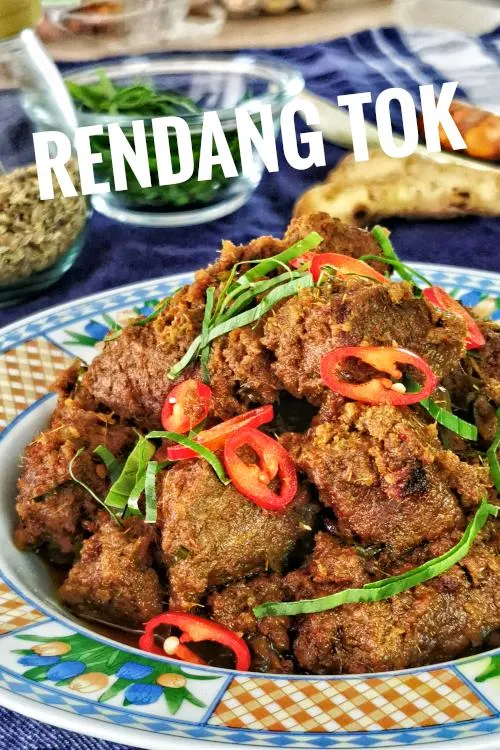
1. The cut of beef for cooking rendang tok
I bought about 1kg of beef brisket for making this mouthwatering rendang today. You can also use other cuts such as chuck tender, rump, and topside. These are the cuts that are juicy and tender after cooking for a long time.
You may want to trim off any tough tendon and fat. I like to remove the excess fat for health reasons, but you may leave it if you wish to indulge in its heavenly taste.
Cut the beef into large chunks, about one to two inches long. The beef will shrink a bit after prolonged stewing, so it is best to cut slightly larger than you want.
I do not marinate the beef as indicated in some recipes. Since I will cook the beef for a few hours, the flavor should have been infused into the meat. In addition, I prefer to saute the spice paste until aromatic, which is not possible if I use it to marinate the beef.
2. Prepare the spice paste
There are wet and dry spices in the Malaysian rendang recipe, which require preparation separately.
The spice paste consists of onion, garlic, lemongrass, ginger, turmeric, galangal, candlenuts, and dried chili. These spices deliver a combination of aromatic flavors and form the body of the gravy.
The combination is different from other rendang recipes, and therefore yields a flavor unique to rendang tok.
Preparation is straightforward:
- Cut the onion, garlic, ginger, and turmeric into small chunks.
- Remove both ends of the lemongrass. Peel off the outer sheath and use only the inner part. Rough cut the inner part of the lemongrass bulb into small sections.
- Remove the seeds of the dried chili. Soak them in hot water for fifteen minutes or until soft.
- Place all the ingredients plus the candlenuts in the blender. Add sufficient water until it can carry the ingredients to move in a circular motion, forming a whirlpool.
- Blend the ingredients for a minute or until it becomes a thick paste.
3. Get ready the spice powder and dry spices
I divide the dry spices into two groups.
The first group consists of cumin, coriander, and fennel seeds. I toast the fresh seeds and blend them into powder. You can take a shortcut by using the ground coriander seeds and other spice powder, commonly available in grocery stores.
The second group consists of cinnamon bark, cardamom, star anise, and cloves. The name of the spice combination is Empat Sekawan (means four buddies in Malay), commonly used in different Malay cooking. They are usually sauteed with oil in the first step of cooking. Other ingredients are added once they turn aromatic.
4. Other ingredients to cook rendang
Coconut milk
I always used fresh coconut milk directly extracted from the coconut. It is available in every market and most of the supermarkets.
You should refrigerate the fresh coconut milk (called santan in Malay) s it can turn rancid quickly. However, it is stable once frozen, which is stable for up to a few weeks.
You can use the coconut milk in a can or box if the fresh one is unavailable. Since the translation of santan can either be coconut milk or cream, you need to make sure to get the correct product. The best way is to ignore whether it is labeled milk or cream since it is confusing. Instead, check the ingredient statement to find out the content and the amount of fat. It should only contain coconut milk or extract, with permissible food additives. The fat content should be about twenty percent. It is for cooking only and is way too concentrated for drinking.
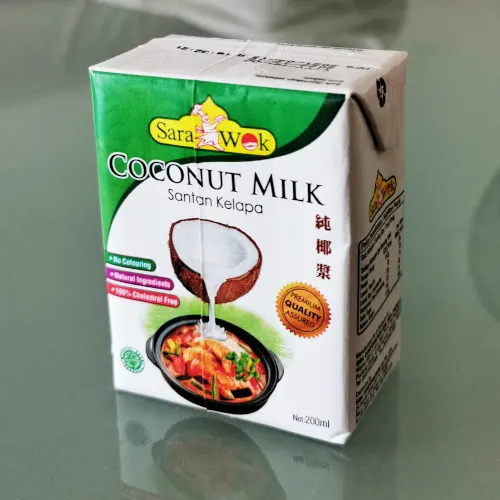
Kerisik
Another essential ingredient is the toasted coconut shavings (called kerisik in Malay), available in most grocery stores. I made it from scratch as the color of the store-bought one is too dark, and I prefer to toast it to light golden only. Kerisik is widely used in preparing various types of Malaysian style rendang,
Asam keping (Asam gelugur)
Asam keping is the sun-dried slices of the fruits of Garcinia atroviridis. It adds a unique sour note to the rendang. The closest substitute is tamarind paste, called asam Jawa in Malay. They are different plant species, but both provide a sour note to the local dish.
Palm sugar
Palm sugar is made from the sap of flower buds from the coconut palm. It is also known as Gula Melaka (Malacca sugar) in English as it is originated from Malacca. It has its unique flavor but can be substituted with brown sugar if unavailable. Palm sugar is used to balance the sourness of the asam keping and to provide a slightly sweet taste to the savory rendang tok.
Dried chilies
I used about 15 small dried red chilies in the recipe. You may want to adjust the heat level by adding more birds’ eye chilies or reducing the amount. Since dried chilies are hard to blend, it is better to soak them in hot water for at least fifteen minutes or until soft before using it to blend with other spices. You need to remove the seeds since they are pretty hot.
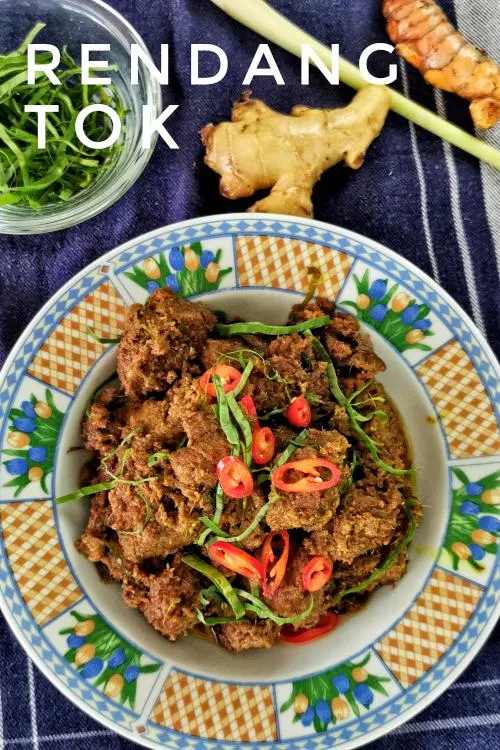
How to make Rendang Tok- the cooking process
Here is the detailed process of preparing rendang tok, assuming you have all the Mise en place ready.
Cook the spices
- Heat about half a cup of oil in the large wok. Use cooking oil generously when cooking rendang, which is essential to produce is rich and glossy gravy.
- Place the dry spices (cinnamon, cardamom, star anise, and cloves) into the oil over medium heat. Let it saute for a little while until you start to smell the aroma rising from the wok.
- Add the blended chili paste and toasted spices, then saute over medium heat for the next ten minutes. The water in the spice paste will evaporate eventually, and the color will darken after that.
Stew the beef
- Add the beef cubes, followed by the coconut milk. Mix thoroughly and wait until it comes to a boil.
- Adjust the heat to a minimum to cook the rendang at barely simmering temperature. Cover it with the lid and let it stew for at least three hours. Give it a few stirs from time to time during the stewing process to prevent the spices from sticking to the bottom of the wok. The color of the gravy will turn from light brown to dark brown gradually over time, as the water continues to evaporate away, and the beef is slow-cooked in its fat and the vegetable oil. You can see the oil separating from the beef and gravy at this stage. This phenomenon is called pecah minyak (means oil-breaking literally) in Malay, which indicates that most water has evaporated.
Include the remaining ingredients
- Add the asam keping, kerisik, palm sugar, and season with salt and black pepper.
- Sprinkle some thinly sliced turmeric leaves into the wok, and then continue to cook for another half to one hour over the smallest flame of your stove. There is no need to add water. Rendang tok is a dry beef rendang dish.
- The gravy will eventually turn dark brown after prolonged slow cooking over low heat, and a concentrated aroma of spices will waft up from the wok. The beef is tender, soft, and ready to serve now.
- You can garnish the rendang with some thinly sliced red chilies and the remaining slices of turmeric leaves (daun kunyit) or kaffir lime leaves (daun limau purut).
How to store Rendang Tok
Perfectly cooked rendang tok taste even better on the next day. It can last for a few days in the refrigerator. However, the flavor can slowly deteriorate over time, and therefore it is best to freeze it if you intend to keep it for a longer time.
Other rendang recipes
I recommend you to try other rendang recipes which taste different from Rendang Tok. Both recipes are on this recipe blog:
- Beef Minang is originated from Minangkabau in Indonesia. It is perhaps the most popular rendang worldwide.
- My chicken rendang recipe is the classic wet rendang with plenty of sauce. You can imagine it is the hybrid of dry rendang and saucy curry. It is less work to prepare and is ideal for including into your dinner rotation.
Rendang Tok - how to make the best beef rendang from Perak
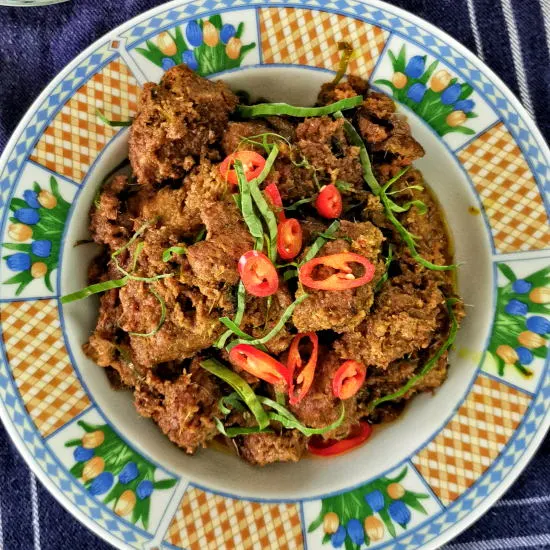
Rendang Tok is the famous beef rendang that originated from the state of Perak. Rendang tok has some Indian influences, including spices like cumin, coriander, and fennel. When combined with galangal, turmeric, and lemongrass, it creates a distinct taste for rendang tok. The texture is further accentuated by the inclusion of kerisik, making it richer and creamier.
Ingredients
Ingredient A (beef)
- 1 kg beef (brisket, rump, topside, or chuck tender), cut into 1-2 inches length
Ingredient B (spice paste)
- 250g onion
- 6 cloves garlic
- 5 lemongrass
- 40g ginger
- 30g turmeric
- 40g galangal
- 3 candlenuts
- 15 small dried chilies, remove seeds and soaked until soften
- Half cup water, or more if necessary
Ingredients C (dry spices)
Ingredients D (dry spices)
Ingredients E (others)
- 100ml cooking oil
- 400ml coconut milk
- 4 tbsp kerisik (see note)
- 1 piece asam keping
- 60g palm sugar
- 2 tsp salt
- 1/4 tsp ground black pepper
- 2 turmeric leaves, thinly sliced
- Sliced red chili for garnishing
Instructions
Preparation:
- Cut the beef into 1-2 inches cubes
- Cut the onion into large chunks.
- Cut the ginger, turmeric, and galangal into small pieces.
- Remove both ends of the lemongrass and the outermost sheath. Cut the bulb area of the lemongrass crosswise into thin slices.
- Remove the seeds of the dried chilis, and soak them in hot water until soft.
- Place all the ingredients in B into a blender. Blender the ingredients until they form a smooth paste.
- Toast ingredients C in a pan until fragrant. Transfer to a blender and grind to become powder.
Cooking
- Saute Ingredients in D with oil in the large wok, over low heat until aromatic.
- Add the spice paste and ground spices. Saute over medium heat for the next ten minutes.
- Add the beef cubes, followed by the coconut milk. Mix thoroughly and wait until it comes to a boil.
- Adjust the heat to a minimum. Let it stew for at least three hours.
- After three hours, add the asam keping, kerisik, and palm sugar, and season with salt and black pepper.
- Add some thinly sliced turmeric leaves, and then continue to cook for another half an hour.
- Transfer the rendang to a serving plate, garnish with more turmeric leaves and thinly sliced red chilies.
Notes
To make kerisik, place the coconut shavings in a dry pan. Toast over medium heat and constantly stir to prevent burning. Transfer it to a blender and process it to become fine granules when it turns golden.
Recommended Products
As an Amazon Associate and member of other affiliate programs, I earn from qualifying purchases.
-
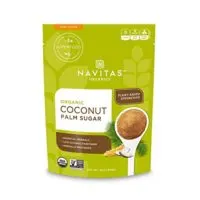 Navitas Organics Coconut Palm Sugar, 16 oz. Bag — Organic, Non-GMO, Gluten-Free, Sustainable
Navitas Organics Coconut Palm Sugar, 16 oz. Bag — Organic, Non-GMO, Gluten-Free, Sustainable -
 GreenLife CW002044-002 Healthy Nonstick Dishwasher Oven Safe Sta Soft Grip Diamond Reinforced 8" Ceramic Non-Stick Open Frypan, 8-Inch, Black
GreenLife CW002044-002 Healthy Nonstick Dishwasher Oven Safe Sta Soft Grip Diamond Reinforced 8" Ceramic Non-Stick Open Frypan, 8-Inch, Black -
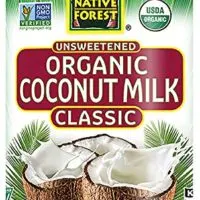 Native Forest Organic Classic Coconut Milk, 13.5 Ounce Cans (Pack of 12),Packaging may Vary
Native Forest Organic Classic Coconut Milk, 13.5 Ounce Cans (Pack of 12),Packaging may Vary -
 Akasa Kerisik 100g (1 Pack)
Akasa Kerisik 100g (1 Pack)
Nutrition Information:
Yield:
5Serving Size:
1Amount Per Serving: Calories: 1144Total Fat: 70gSaturated Fat: 33gTrans Fat: 1gUnsaturated Fat: 30gCholesterol: 194mgSodium: 1466mgCarbohydrates: 70gFiber: 9gSugar: 24gProtein: 69g
This data was provided and calculated by Nutritionix on 1/11/2022

MP
Sunday 24th of April 2022
Did I miss what we are to do with the D ingredients?
KP Kwan
Monday 25th of April 2022
Hi MP, Thanks for pointing out the error. The first line of 'cooking' in the recipe is now read as 'Saute Ingredients in D with oil in the large wok, over low heat until aromatic.". I have corrected the mistake. KP Kwan
KP Kwan
Tuesday 11th of January 2022
Hi, this is KP Kwan. I am happy to see you in this comment area, as you have read through my recipe. I am glad to reply to any questions and comments as soon as possible.